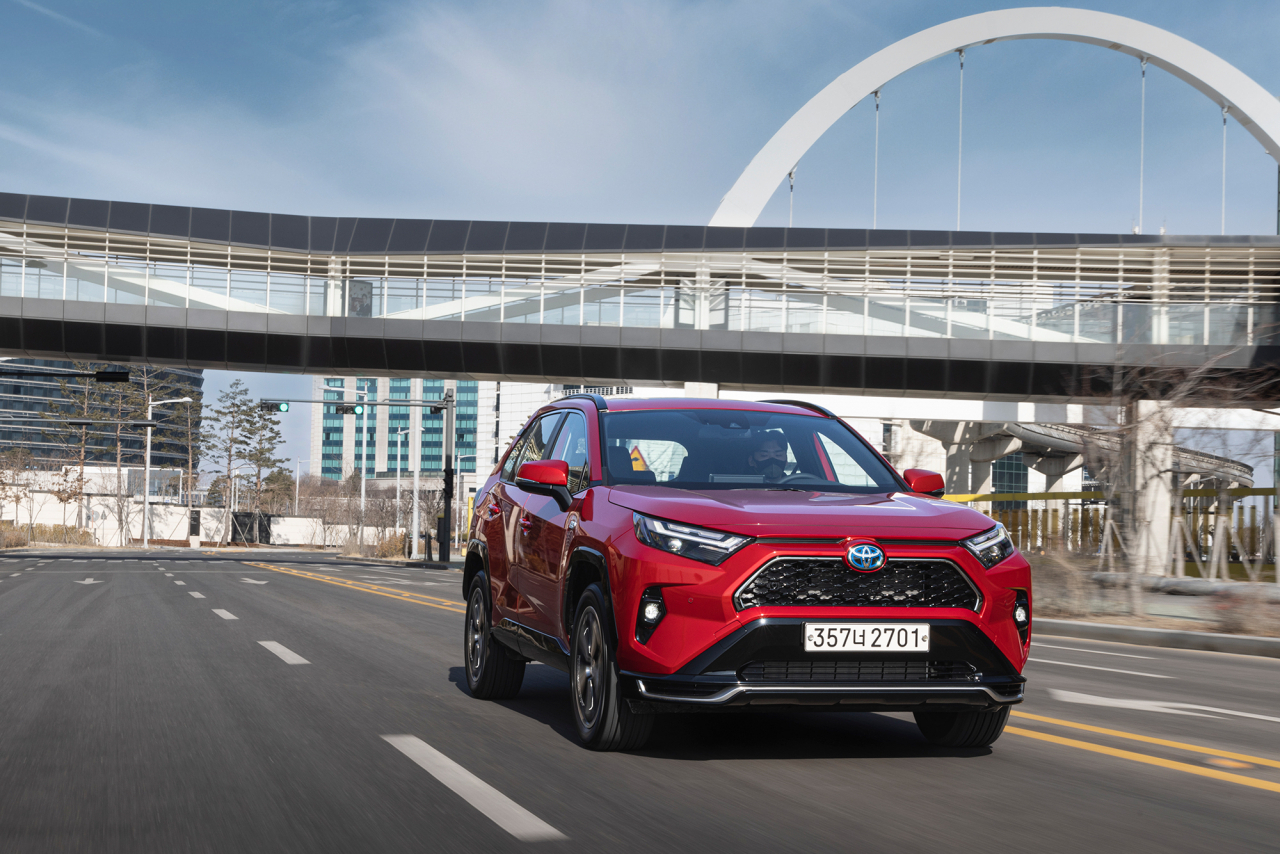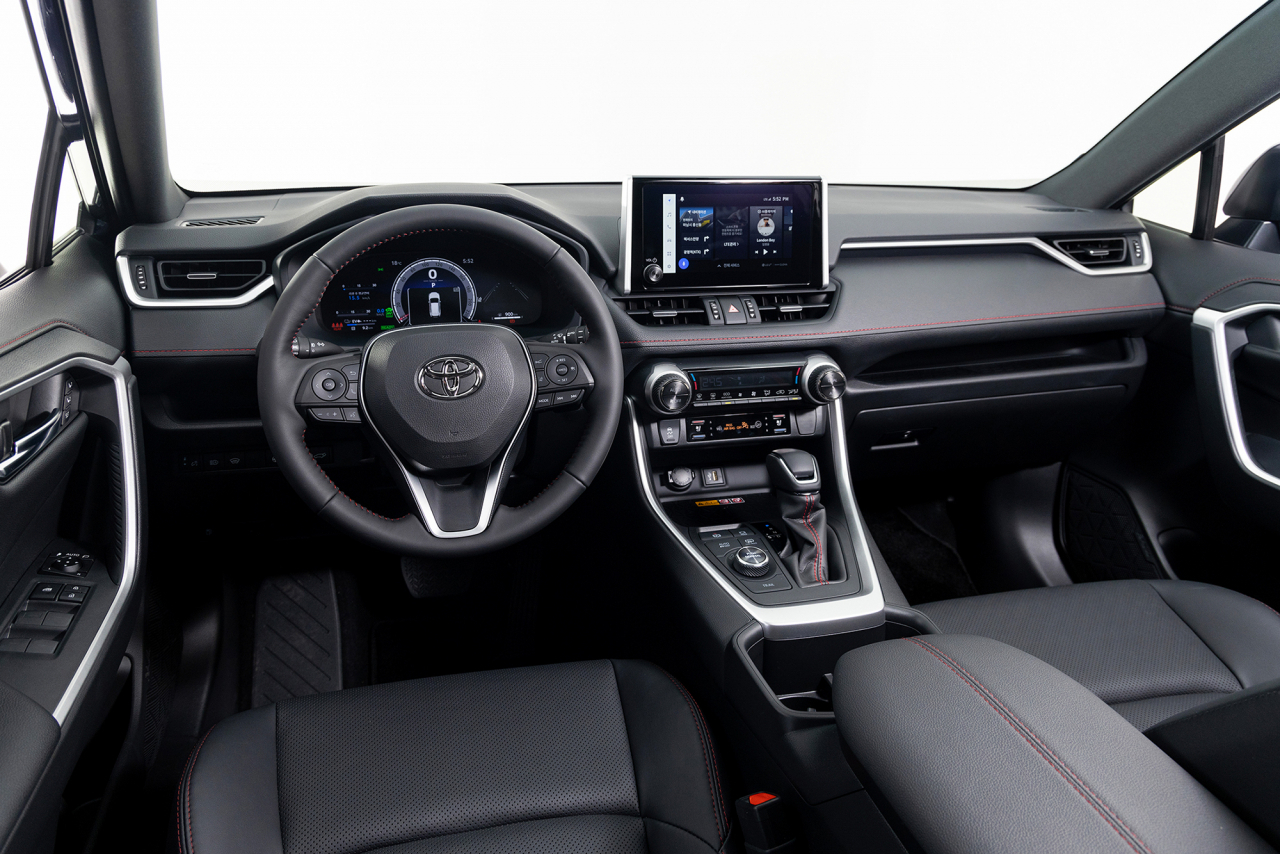[Test Drive] RAV4 Plug-in Hybrid, Toyota’s latest offering for EV hesitators
New RAV4 combines best qualities of electric, gas cars for city commuters
By Byun Hye-jinPublished : Feb. 26, 2023 - 18:04

After years of supply chain disruptions and diplomatic tensions, Japanese auto giant Toyota is seeking a turnaround in Korea with its first offering to win back customers -- the new RAV4 Plug-in Hybrid, which combines the best qualities of gas and electric cars.
The plug-in hybrid model is the latest addition to the carmaker’s popular RAV4 crossover utility vehicle lineup. In Korea, the self-charging RAV4 Hybrid was Toyota’s top-selling hybrid car last year, making up 43 percent of hybrid sales and outpacing the Camry Hybrid sedan.
The latest RAV4 Plug-in Hybrid, which can drive up to 63 kilometers in electric mode, made its Korean debut on Tuesday.
The car offers four driving modes – Electric, Hybrid, Auto EV/HV and Charge Hold, which can be switched via buttons. The HV mode uses both electric power and a gas engine, while the Auto EV/HV model mostly drives on electricity except when it needs more power and speed. When the battery is about to run out, the Charge Hold mode secures some electric range while driving with energy from the petrol engine.
The Korea Herald’s recent test drive of the car was conducted Thursday from the eastern part of Seoul to Yongin, Gyeonggi Province, which is a round-trip course of some 50 kilometers.
Its 2.5-liter four-cylinder engine and two electric motors can get 306 horsepower combined, making it the second-most powerful Toyota vehicle only after its sports car GR Supra 3.0, according to Toyota Korea. Its fuel economy and electric mileage ranges are estimated at 15.6 kilometers per liter and 4.2 kilometers per kilowatt, respectively.
The reporter drove the car uphill in the Auto EV/HV mode, but it took little effort to accelerate speed and power. The EV mode allowed for a smooth driving experience both on the road and through curves.
The upgraded sensor system also worked effectively when another car cut in front of the vehicle, as it made an alert sound and automatically helped with the braking.

One of the key distractions, however, was that the steering felt a lot heavier on the Charge Hold mode. There was also noticeably louder noise from the engine.
As for design, the red stitches on the car seats add a sporty vibe. The exterior embraces Toyota’s “cross octagon” concept with bold and masculine lines. Compared to the previous-generation model launched in 2019, the new fifth-generation model is shorter overall, but has a longer wheelbase.
For potential buyers who are still hesitant about going fully electric, the RAV4 Plug-in Hybrid is a compromise that offers the best of gas and electric cars. Even compared to other hybrids, the RAV4 Plug-in Hybrid comes with a larger battery pack that means a longer electric-only range.
The issue is Toyota’s market position in Korea, where its rival Hyundai Motor Group dominates almost 90 percent of car sales, including those for eco-friendly models.
Even though its luxury sibling brand Lexus seems to be securing a niche in the crowded high-end segment, Toyota has struggled to regain its footing in the mass market here.
In an apparent move to breathe fresh air into its Korea strategy, Toyota Korea aims to launch eight new electric vehicles this year alone.
“Korea is sensitive to new trends. We will introduce powertrains and automation that can meet customers’ various needs and lifestyles and also fit the driving environment here,” Toyota Motor Korea CEO Konyama Manabu said during the launch event of the RAV4 Hybrid in Seoul last week.
“The support and trust from Korean customers are big assets. They will bring a bright future for the automation we envision moving forward.”
The price of the single-trim car is set at 55.7 million won ($42,900).





![[KH Explains] No more 'Michael' at Kakao Games](http://res.heraldm.com/phpwas/restmb_idxmake.php?idx=644&simg=/content/image/2024/04/28/20240428050183_0.jpg&u=20240428180321)













![[Herald Interview] Mistakes turn into blessings in street performance, director says](http://res.heraldm.com/phpwas/restmb_idxmake.php?idx=652&simg=/content/image/2024/04/28/20240428050150_0.jpg&u=20240428174656)
